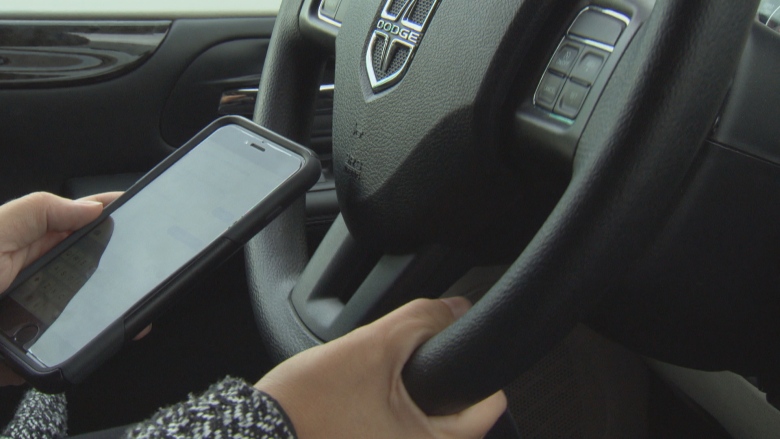'A look of guilt': Distracted drivers rarely argue after being caught, Vancouver traffic officer says
Police say it's easy to catch people with their heads down tapping on phones at red lights

The number of people being caught each year by police for distracted driving, primarily using their mobile phones, is decreasing, but police say there is still enough of it going on to endanger roads.
Under theB.C. Motor Vehicle Act, it's illegal to use an electronic device while operating a motor vehicle. If you are caught, the penalty is a $368 fine and fourdriver penalty points,which means higher fees to insure your vehicle.
Statistics from ICBC show that in 2017, 39,000 people received violation tickets for the use of an electronic device while driving 10,000 fewer than were ticketed in 2014.
The province says that research shows that it's dangerous to use an electronic device in a car because drivers are half as attentive while using one.
Staff Sgt. Dave Duncan with the Vancouver Police Department's traffic section says habits around using phones in cars are changing. He sayspolice rarely stop people holding the phone up to their face while driving, or like a piece of pizza to talk into one on speaker.
Duncan says that people now find other less obvious ways to use their phones, such as putting it in a coffee cup or wedging it in their clothing. The biggest offence he and his officers see though, is phone use while stopped at traffic lights, which he says is still dangerous and illegal.
'Oh, I've been caught'
To enforce the rules, officers stand at intersections, wait for vehicles to stop at red lights and watch for a driver's head drop.
Duncan says he can observe the driverunaware on their device for up to 15 seconds before he taps on their window.
"Usually the expression ... is a look of guilt, a look of 'oh, I've been caught,'" he said."And I actually don't have very many people argue with me because they know that I've been standing there for so long."
Duncan says the excuses offered such as "I was just plugging it in"or, "I was just checking what time it was"or "I got a message"are weak because they all involve the illegal use of phone in a vehicle.
Recent decisions fromB.C. courtsaboutpeople challenging the tickets seem to support that it's a tough sell especially if officers like Duncan provide detailed descriptions of what they observe such as the type of phone, what app was open and what fingers were being used.
What's allowed?
Duncan says two recent decisions, one from 2017 and one from 2019 have helped to pinpoint what's allowed and what isn't.
In the 2017 case R. v. Jahani, thecourts found that plugging in your phone to charge it while driving isa contravention. Plugging it in before you start driving is allowed.
In 2019, the case R. v. Partridge established that having the phone unsecured in your vehicle, like sitting on the seat next to you, wasn't anoffence. Police had originally ticketedPhilipPartridge because they believed he was looking at his phone.
Duncan says unrestricted Class 5 drivers may use their cell phone hands freeas long as the device is securely mounted to the vehicle. They canuse one touch to answer or end calls.
Drivers can followGPS settings, but those have to be programmed into the phone before driving starts. Afterwards drivers arenotallowed to hold the device, touch it or watch the screen for any other purpose.
New or learningdrivers are not allowed to use electronic devices at all, not even hands free.












_(720p).jpg)


 OFFICIAL HD MUSIC VIDEO.jpg)
.jpg)



























































































